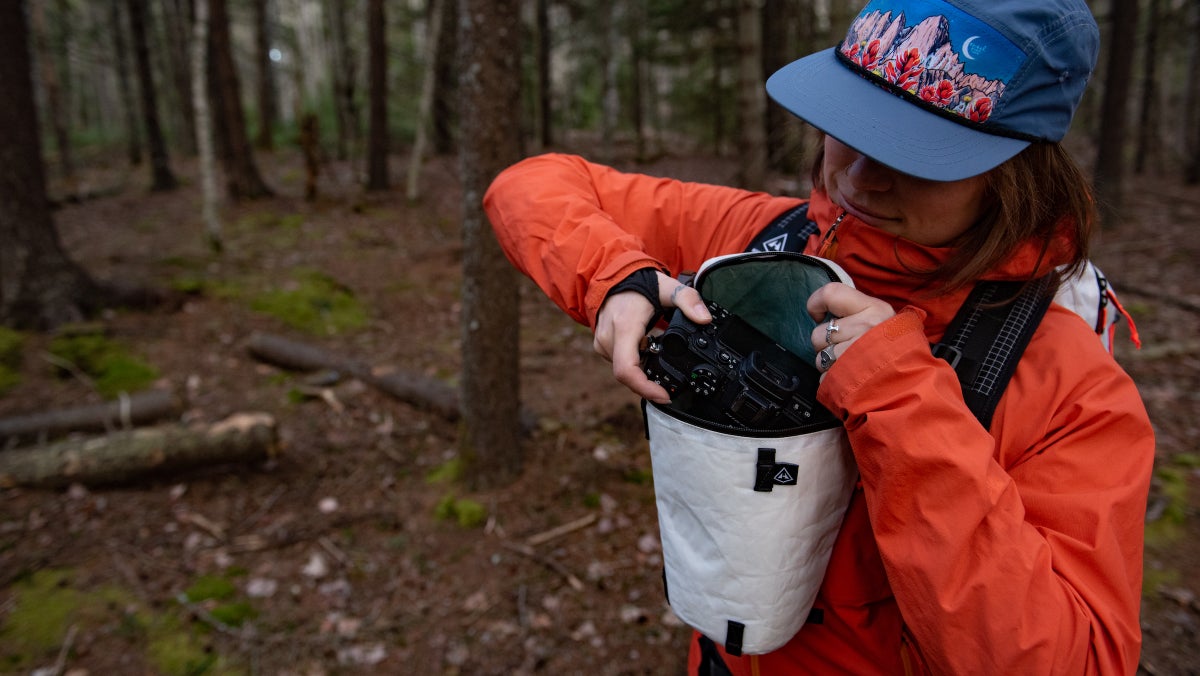No products in the cart.
Outdoor Adventure
Hyperlite Mountain Gear’s Camera Pod is the Best Way to Carry Your Camera on Adventures
If travel is a gateway drug, photography is the next hardest substance. Blended, the two make a potent cocktail. On ski trips, backpacking trips, and forays into foreign cities, the search for a unique photograph has often brought me to places I might not have otherwise explored, like a peak or neighborhood that wasn’t on the itinerary.
And like most drugs, this speedball doesn’t come cheap. If you think ski gear is expensive, check out the prices on a decent camera setup. The addiction doesn’t end at electronics, either; there’s mirrorless lenses, tripods, straps, and filters to go with it.
As a writer and photographer in the outdoor industry, I’ve had the opportunity to test nearly every adventure-oriented camera bag you can buy. But what I wanted most was an efficient way to carry my camera while scrambling around mountains, forests, and deserts all over the world. It only took me six years to find it.
On my quest, I interviewed professional adventure photographers like Jimmy Chin, Jeff Johnson, Savannah Cummins, and Chris Burkard about the bags, straps, and pouches they use in the field. (Admittedly, these stories were as much for my own benefit as for yours.) Their insights confirmed my hunch: there are countless ways to carry a camera in the backcountry, but there is no single best way.
Undaunted, I trawled Instagram to learn what other photographers were using and scoured blogs and vlogs for brands and products I might’ve overlooked. I didn’t expect to find the one above the Arctic Circle, in Norway, aboard a 90-foot fishing vessel repurposed for ferrying travelers to the remote anchorages of Senja and other nearby islands. I was there with nine others to ski remote peaks and, many of us being photographers, hauling twice as many cameras as people to document the adventure. I immediately noticed that two of the members of our group used the same accessory for camera carry: a compact, triangular, black pouch with a zippered top made by Hyperlite Mountain Gear called the Camera Pod (from $109).

Like the ultralight backpacks and shelters that Hyperlite is known for, the Camera Pod is made from a Dyneema composite fabric skin. Dyneema, formerly called Cuben Fiber, is an ultra-high-molecular-weight polyethylene, essentially a super-ultralight fiber that’s 15 times stronger than steel by weight. The Dyneema in the Camera Pod’s composite skin is melded to a 150-denier polyester fabric to thicken it up for use outdoors. Between that and an inner lining made of an even thinner Dyneema, a layer of quarter-inch-thick closed-celled foam adds padding. All this is to say that the thing is lightweight—a large Camera Pod is 106 grams, slightly heavier than a stick of butter—yet extremely impact resistant. Oh, and it’s water resistant against rain and snow, too.
The Camera Pod comes in two sizes. Regular fits small mirrorless and point-and-shoot cameras, and large holds bigger mirrorless and DSLR setups. Beyond fabric and form, there are eight webbing loops, including one on each corner, for securing to a belt or backpack. It’s a hell of a lot simpler than other camera backpacks, shoulder bags, and organizing cubes with their folding Velcro dividers and magnetic access points.
In Norway, one of my companions split boarded up and down peaks with his Camera Pod fixed to his backpack’s hipbelt, holster-style, and was able to draw his camera and capture a moment with a few seconds’ notice. I asked him what he liked about it, and he said, “It gives me the confidence to keep the camera outside of my pack and on my hip or my chest no matter the weather. I find myself carrying it more and taking more photos than if I had to dig my camera out of the pack.” He’s brought his camera rock and ice climbing, on surf trips, and even on a 5,000-mile moto journey across Africa. I had to have one.
My Camera Pod’s first big trip was a four-day bikepacking adventure through northern New England via back roads and rail trails. Beyond pedaling 60 miles each day, I was tasked with documenting the trip for an editorial story about a cycling apparel brand. With a couple of zip ties and a piece of bungee from my local gear shop, I rigged the Camera Pod to my handlebars and frame so my camera was nearly as accessible as my water bottles.
A good camera bag provides two things: protection and easy access. Many do this well—I like Peak Designs’ Everyday Backpack ($280) and Moment’s Rugged Camera Sling ($130)—but few to none do this for skiing, climbing, or riding a bike 250 miles, and those that claim to often dedicate too much space to cameras and lenses.
No, the Camera Pod can’t carry a full multi-lens kit, but any bag can do that with an aftermarket organizer like Peak Designs’ Camera Cube ($50). Instead, the pod is complementary to whatever vessel you carry the rest of your gear in. Tied directly to your hip or chest, it allows you to spend less time digging around in a bag and more time focusing on the shot.

